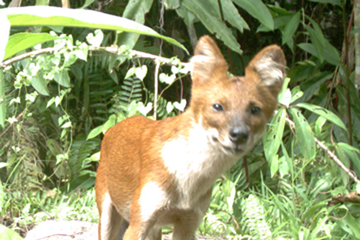Kenyir Wildlife Corridor in northeast Malaysia is teeming with wildlife: elephants, gibbons, tigers, tapirs, and even black panthers (melanistic leopards) have been recorded in the 60 kilometer (37 mile) stretch of forest. In fact, researchers have recorded over 40 mammal species (see species list below), including 15 threatened with extinction according to the IUCN Red List. When these findings were presented by scientists to the Terengganu state government action followed quickly: all development projects have been halted pending a government study.
“We will not hesitate to gazette the site if the findings reveal that it is of environmental importance,” Datuk Toh Chin Yaw, chairman of the Terengganu State Industry, Trade and Environment Committee, told fz.
Connecting Taman Negara National Park—the country’s largest—to other forests in Terengganu, Kenyir Wildlife Corridor sports a stunning abundance of wildlife, according to Reuben Clements, who has been taking remote camera photos in the forest for years.
 A melanistic leopard, more popularly known as a ‘black panther,’ photograph in the Kenyir Wildlife Corridor. Photo courtesy of Reuben Clements. |
“This corridor has been highlighted by the Federal government as one of Malaysia’s primary ecological linkages and it’s a vital bottleneck for animals,” Clements, a PhD student at James Cook University and a Research Associate with Universiti Malaya, told mongabay.com. “[The] diversity [of wildlife] is as high as that recorded from camera trap surveys conducted in Taman Negara more than 10 years ago.”
In addition to over 40 mammal species, the forest is also home to nearly 290 birds, including nine of ten of Malaysia’s hornbill species. Still a halt on development plans does not mean the corridor is saved or that its species don’t face additional threats.
“The main threats to this corridor is conversion of forests to improperly planned eco-tourism infrastructure and poaching, especially by foreigners from Indo-China,” Clements says. “There is also a threat from the legal conversion of forest reserves to monoculture rubber plantations, but the state government has assured us this won’t happen for now.”
Clements and colleagues are now working with the state government in hopes to secure full protected status for the corridor.
“We have submitted our recommendations to the state government and environmental consultants, detailing areas in the corridor that should be spared from conversion, as well as measures to deter poaching,” he notes.
Scientists say that increasing protection for corridors like Kenyir could be key to preserving populations of Asian elephant (Elephas maximus), the Malayan tiger (Panthera tigris jacksoni), and other species that require a huge expanse to thrive and don’t heed protected area boundaries.
The halted development is another success story for a unique and young organization of scientists, Rimba. Another Rimba member, Ahimsa Campos-Arceiz, has been working closely with government agencies to mitigate human-elephant conflict across peninsular Malaysia.
 A dhole photographed on camera trap. This species is considered Endangered. Photo courtesy of Reuben Clements. |
Founded just two years ago, Clements explains that “Rimba is not an NGO, consultancy nor a society—they are non-profit research group registered in Malaysia and are dependent on grants and donations to remain operational.”
He says Rimba is not against economic development, but believes “impacts can be minimized.”
“Apart from pursuing fundamental research, Rimba conducts applied scientific research with the ultimate aim of developing evidence-based management recommendations to help decision-makers reduce threats to ecosystems and species in Malaysia,” Clements adds.
It appears that the Malaysia government, both at the national and state levels, are listening.
“The state government has been receptive to scientists who can provide adequate justifications for the environmental causes they are pursuing,” Clements says, nothing that, “earlier this year, the state government helped us ban the hunting of flying foxes (Pteropus vampyrus) after submitting a proposal that highlighted the economic and biological importance of this threatened species.”
Mammal species found in the Kenyir Wildlife Corridor to date
Dhole (Cuon alpinus), Endangered
Asian Elephant (Elephas maximus), Endangered
White-handed Gibbon (Hylobates lar), Endangered
Sunda Pangolin (Manis javanica), Endangered
Malayan Tiger (Panthera tigris jacksoni), Endangered
Asian Tapir (Tapirus indicus), Endangered
Binturong (Arctictis binturong), Vulnerable
Gaur (Bos gaurus), Vulnerable
Serow (Capricornis sumatraensis), Vulnerable
Sun Bear (Helarctos malayanus), Vulnerable
Banded Palm Civet (Hemigalus derbyanus), Vulnerable
Pig-tailed Macaque (Macaca nemestrina), Vulnerable
Clouded Leopard (Neofelis nebulosa), Vulnerable
Marbled Cat (Pardofelis marmorata), Vulnerable
Sambar Deer (Rusa unicolor), Vulnerable
Leopard (Panthera pardus), Near Threatened
Golden Cat (Pardofelis temminckii), Near Threatened
White-thighed Leaf Monkey (Presbytis siamensis), Near Threatened
Pale Giant Squirrel (Ratufa affinis), Near Threatened
Dusky Leaf Monkey (Trachypithecus obscurus), Near Threatened
Large Indian Civet (Viverra zibetha), Near Threatened
Small-toothed Palm Civet (Arctogalidia trivirgata), Least Concern
Brush-tailed Porcupine (Atherurus macrourus), Least Concern
Prevost’s Squirrel (Callosciurus prevostii), Least Concern
Moonrat (Echinosorex gymnura), Least Concern
Crab-eating Mongoose (Herpestes urva), Least Concern
Malayan Porcupine (Hystrix brachyura), Least Concern
Three-striped Ground Squirrel (Lariscus insignis), Least Concern
Long-tailed Macaque (Macaca fascicularis), Least Concern
Yellow-throated Marten (Martes flavigula), Least Concern
Barking Deer (Muntiacus muntjak), Least Concern
Common Palm Civet (Paradoxurus hermaphroditus), Least Concern
Leopard Cat (Prionailurus bengalensis), Least Concern
Banded Linsang (Prionodon linsang), Least Concern
Bamboo Rat (Rhizomys sumatrensis), Least Concern
Wild Pig (Sus scrofa), Least Concern
Malay Civet (Viverra tangalunga), Least Concern
Malay Peninsula Pithecher (Pithecheir parvus), Data Deficient
Related articles
Learning to live with elephants in Malaysia

(09/18/2012) Humans and elephants have a lot in common: both are highly intelligent, intensely social, and both are capable of having a massive impact on their local environments. Given their similarities, it might not be surprising that elephants and human have often run afoul of one another. Conflict between these two great species has probably been going on for thousands of years, but as human populations have grown dramatically, elephant populations have been crippled and forced into smaller-and-smaller pockets. No-where is this more true than in Southeast Asia.
Photos: camera traps capture wildlife bonanza in Borneo forest corridor

(09/10/2012) Camera traps placed in a corridor connecting two forest fragments have revealed (in stunning visuals) the importance of such linkages for Borneo’s imperiled mammals and birds. Over 18 months, researchers with the Sabah Wildlife Department (SWD) and the Danau Girang Field Centre (DGFC) have photographed wildlife utilizing the corridor located in the Lower Kinabatangan Wildlife Sanctuary in Malaysian Borneo.
New Malaysian snail named after late conservation mentor
(07/30/2012) Researchers have discovered a new snail, which is so unusual that it has been granted its own genus: Kenyirus. To date, the mysterious forest snail, found in Malaysia’s Kenyir Forest, is only known from its unique shell.
Industrial logging leaves a poor legacy in Borneo’s rainforests

(07/17/2012) For most people “Borneo” conjures up an image of a wild and distant land of rainforests, exotic beasts, and nomadic tribes. But that place increasingly exists only in one’s imagination, for the forests of world’s third largest island have been rapidly and relentlessly logged, burned, and bulldozed in recent decades, leaving only a sliver of its once magnificent forests intact. Flying over Sabah, a Malaysian state that covers about 10 percent of Borneo, the damage is clear. Oil palm plantations have metastasized across the landscape. Where forest remains, it is usually degraded. Rivers flow brown with mud.
Charts: deforestation in Indonesia and Malaysia, 2000-2010

(07/15/2012) Indonesia and Malaysia lost more than 11 million hectares (42,470 square miles) of forest between 2000 and 2010, according to a study published last year in the journal Global Change Biology. The area is roughly the size of Denmark or the state of Virginia. The bulk of forest loss occurred in lowland forests, which declined by 7.8 million hectares or 11 percent on 2000 cover. Peat swamp forests lost the highest percentage of cover, declining 19.7 percent. Lowland forests have historically been first targeted by loggers before being converted for agriculture. Peatlands are increasingly converted for industrial oil palm estates and pulp and paper plantations.
Malaysia to restrict trade in big-eyed sugar gliders
(04/20/2012) Malaysia will tighten controls on the trade in sugar gliders, a big-eyed gliding possum increasingly popular in the pet trade in Southeast Asia and the United States, according to the country’s Department of Wildlife and National Parks (Perhilitan).